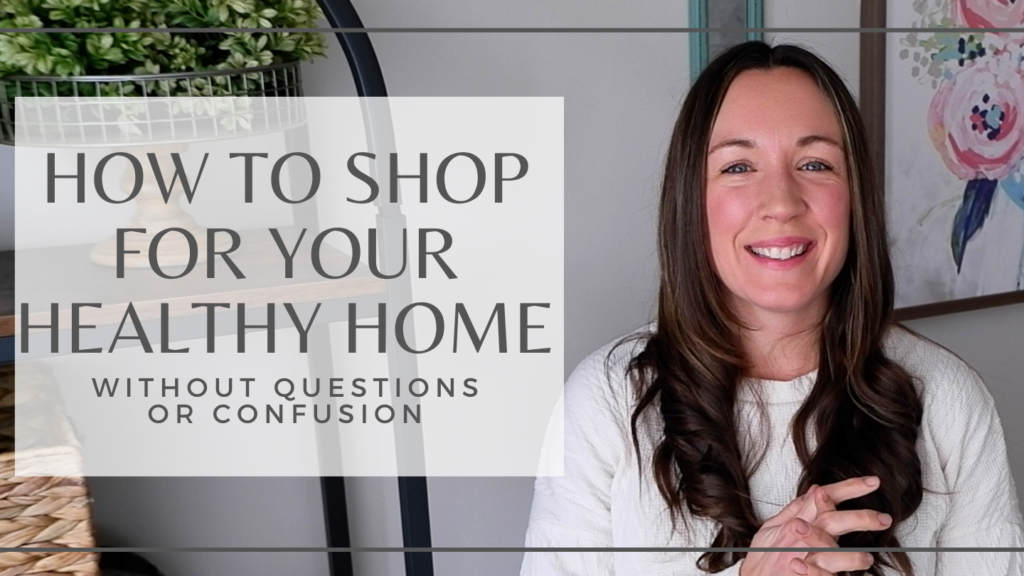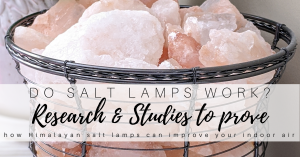
I’ll be honest, even with myself, the thought of buying non toxic home products can feel really overwhelming. It sounds like a great idea, but a lot of times we don’t know where to start.
You might wonder where you buy organic and non toxic home products that have third party certifications? Are there really stores that carry these types of things? The truth is, it can be really difficult to find safe and healthy products for your home in a big box store. However, if you know what to look for and do some research ahead of time, you certainly can pick eco-friendly and natural items for your home when you’re out and about.
There are a few small things that can help you narrow down HOW to do your regular shopping with the health of your home in mind.
And that’s just what you can expect from this post — the ins and outs of purchasing everyday items that are actually non toxic home products and personal products without the overwhelming feeling.

NON TOXIC HOME PRODUCTS SHOPPING PLANS:
Shop with a List & Stick To It
One of the best things I’ve done for my home (and my budget) when it comes to my healthy home is to create a list of what I want or need to buy and then STICKING TO IT.
We keep a running list of items that we plan to replace. This list is usually bigger things that I’ve been planning for. Things like home decor, kitchen items, small pieces of furniture, etc. And then I also keep a list of products that need to be replenished, swapped or purchased. This list is often things like personal care items, toiletries and cleaning supplies.
The trick is, if a non toxic home product isn’t on that list, I generally don’t get it. And anything that goes on the list, I know I have to look into or research before the time comes to purchase it. And a shared list for your household is a great way to stay on track too.
Arm Yourself with Knowledge
Like I mentioned, anything on either of my lists is something I need to buy that I haven’t gotten before, I know that I need to do some research. I research the toxins that can be associated with each item and then I find alternative ingredients or materials that I can begin searching for. And in the end you’ll be able to find non toxic home products.
For example, if you were planning on buying a life jacket for one of your kids this summer, it might start by researching the PVC foam that can contain toxins in the life jacket. Then, you might start looking for PVC-free life jackets to see where you end up. You can add a few brands to your list you’re keeping like Stohlquist and Astral or Kokatat that all have PVC free life jacket options.
The trick is to know what you want or need BEFORE it’s time to buy or time to go shopping. This gives you an edge up as you will know EXACTLY what to look for.
Be Aware of Greenwashing
And the final piece of the puzzle is knowing when something is greenwashed. In other words, you’ll have to know the language and wording that is misused on packaging before you commit to buying something.
This is becoming a huge problem as so much of the language used on packages is totally unregulated. Things that say green or natural scent are oftentimes a bit misleading as there’s no proof to these claims.
Any brand that is willing to be transparent and give you all the ingredients or materials is often times a brand that can be trusted. But greenwashing is just another reason to be REALLY informed before you buy and almost have your decision made before you go shopping.
HOME MATERIALS YOU CAN TRUST
When it comes to non toxic home products you bring into your house, you should know a few go-to materials you can trust.
Glass: Generally this is a great choice when it comes to decor, kitchen products and food storage. Glass doesn’t leach or absorb anything into it, and so no matter what type of food you put in it, it’s mostly harmless. It’s also a material that doesn’t usually end up with toxic paint on it, nor does off gas any sort of toxin. You do want to avoid recycled glass as it can contain impure materials. And avoid anything with a glaze unless it states it is lead free.
Stainless Steel: Stainless steel is a great material to use in decor, furniture and in the kitchen. Opting for a stainless steel that isn’t painted is best, as some paints can have toxins in them, which is often not disclosed.
Organic Cotton: When you’re getting towels, sheets or any sort of textile, going for 100% organic cotton is best. You can also find textile blends that use wool and cotton together for a different texture. Trying to stay away from synthetic materials in home textiles is best. The nice thing is you can look at the label on the package and see what the content of various materials is. Remember that while cotton is a natural fiber, there can be pesticides in the material.
Solid Wood: Going with solid wood for any material you’re buying for your house is better than opting for pressed woods. Pressed woods like particle board, fiberboard or plywood often contain adhesives that off-gas formaldehyde. This can be a really tough thing to watch for because sometimes the furniture or item may appear to be solid wood, when actually it has pressed wood inside or behind it. This may be something to do research on before you do your shopping, but if you’re out and aware that you need to look for solid wood, it can be helpful.

MATERIALS & CHEMICALS YOU SHOULD KEEP OUT OF YOUR HOME
Textiles with Flame Retardants: Flame retardants can be found in products like furniture, blankets, pajamas and other foam products. Avoiding these can mean decreasing your risk for thyroid disorders, reproductive problems and even cancer. (STUDY) Opt for a material like natural wool or cotton as a filling instead of polyurethane foam. Know that there are labels you can look for on furniture and textiles that will give a warning that flame retardants are present.
Pressed Wood: Pressed woods like particle board, medium density fiberboard (MDF) and plywood are pieces or particles of wood that are glued together with a very strong adhesive. Often times the adhesives contain Formaldehyde, which is a known carcinogen. (STUDY) There are companies that use adhesives in pressed woods that do not contain formaldehyde, but this is the information you’d need to seek out. If nothing else, you can use SafeCoat Safe Seal to seal off any of the pressed wood you have or have bought. This will contain formaldehyde and other VOCs, which will prevent them from off-gassing.
Synthetic Fragrance: Many products that we use in our home for cleaning, personal care or for air freshening contain synthetic fragrances. Synthetic fragrances are basically a concoction of chemicals mixed together to mask the smell of a product. These chemicals often contain volatile organic compounds (VOCs), that affect hormone production and reproductive function. (STUDY). Products that are scented at all should be with plant based ingredients and essential oils. Finding something that is unscented is your best bet when it comes to synthetic fragrances.
TOOLS TO HELP YOU

Third Party Apps: This app is like my lifeline when it comes to shopping for something I need to replace with a healthier option. I use it when buying any sort of makeup, lotion, shampoo, soap, etc. It also has a great database of cleaning products that I use for when I need to replace something or want to find new non toxic home products
Research Ahead of Time: I’ve done that for you a bit with my Green Product Guide that you can reference anytime. But there are lots of ways you can do your research before you go to the store or order online. Simply use Google to search out your product and find out what’s in it or you can even search my website for the item you’re looking for and see if I’ve got a recommendation for non toxic home products.
FakeSpot: If you’re looking for an honest review of something, it can be hard to find. So many companies offer to pay for positive reviews, and it can be really tough to know if what you’re reading is a true opinion. FakeSpot uses an algorithm search to detect how many reviews are fake, and will give you what the REAL rating of a product online is.
The Healthy Home Blueprint: Inside my online course I have a complete guide and recommended product page to help you as you swap things out in your home and purchase new items. It’s a great resource to hang on to and use as you work through your home and make it healthier. If you watch my free training, there’s also a 50% off discount to the Healthy Home Blueprint you will receive.

HOW TO SHOP AT YOUR FAVORITE STORES:
Amazon: If you’re willing to hunt around, you can find what you need quickly and easily on Amazon. There are many items made with low toxin materials and alternatives to chemicals, you just have to know what you’re looking for. The beauty of Amazon is that you can do all your research as you are buying or before you purchase.
It’s also helpful to stick to name-brands or well established brands when it comes to finding non toxic home products.
Target: The biggest trick here is to know what you’re looking for BEFORE you go. Target has a lot of great options for lower toxin textiles, sheets, towels, home products and personal care products. But you can easily get pulled to another item while you’re there, so go with specifics in mind.
And if you’re shopping online, don’t forget this HUGE tool when shopping for non toxic home products: The clean products filter on the left hand side of your search results. It’s the BEST way to weed out the obviously toxic and harmful products right from the get go.
Wayfair: Online stores that carry a lot of home materials and textiles can be tricky to navigate. This is when it might be helpful to search for third party certifications like GreenGuard Gold, GOTS and Oeko Tex Standard 100.
With some of the categories, it can also be easy to find non toxic home products by using the “sustainable” search filter they have. It doesn’t show up all the time, but it does pop up in the left hand search bar for things like furniture. You can check a box for different sustainability practices, including certifications.
It isn’t perfect, but again, it can give you a good starting off point.

Taking even just one small thing away from this post can help you as you work to bring new non toxic home products into your space. Remember, planning ahead and arming yourself with knowledge are your two best tools.




